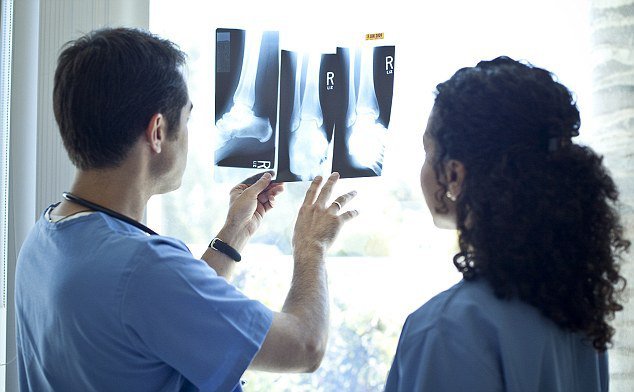Contents:
- Medical Video: Bone Sarcomas | FAQ with Dr. Adam Levin
- What causes bone cancer?
- Various types of bone cancer
- Osteosarcoma
- Chondrosarcoma
- Ewing sarcoma
- Fibrosarcoma
- Chordoma
- Symptoms and signs of bone cancer
- How to diagnose bone cancer?
- Stadium that is in bone cancer
- What is the life expectancy of people with bone cancer?
- Can bone cancer be prevented?
Medical Video: Bone Sarcomas | FAQ with Dr. Adam Levin
Photo source: Daily Mail
Bone cancer is a rare cancer event. At least, bone cancer occurs in only 5% of the total cancer cases in the world. Bone cancer can be experienced by children and adults, resulting from abnormal bone cell growth. If cancer cells are detected for the first time in bone tissue, they can be called primary bone cancer. While bone cancer can also occur due to the spread of other cancers that have previously occurred as in colon cancer, eye cancer, or breast cancer.
For bone cancer that appears due to the spread of other cancers, this is referred to as secondary bone cancer. Cancer that occurs in adulthood, is usually a secondary bone cancer that occurs due to the spread of cancer cells to bone tissue. Primary and secondary bone cancers have different prognoses and treatments.
What causes bone cancer?
Primary bone cancer is very rare, even this case only occurs about 1% of the total cancer cases that exist. Until now it is unclear what causes bone cancer. In theory, bone cancer occurs because there is an error when replicating DNA in bone cells. When the formed DNA is wrong, this results in bone cells developing uncontrollably and growing in large quantities. These uncontrolled bone cells gather into a malignant tumor that can spread to other tissues.
Although the cause is not yet known, the following are risk factors that might lead to the occurrence of bone cancer:
- Genetics. Genetic is a very rare cause in cases of primary bone cancer. However, people who have genes or a history of eye cancer and Li-Fraumeni syndrome have the possibility to experience bone cancer.
- Paget's disease. This disease generally occurs in the elderly group and if you have had this disease it has a high chance of getting bone cancer
- Has a history of cancer therapy. Radiation and some chemotherapy drugs can increase the risk of bone cancer, for example treatment with alkylating agents.
Various types of bone cancer
Bone cancer is divided into several types according to where cancer cells grow in bone tissue. Here are the types of bone cancer that are often found:
Osteosarcoma
Osteosarcoma is a type of primary cancer that often occurs in children and adolescents, which is around the age of 10 to 9 years. This type of bone cancer is also more common in men than women. Cancer cells in osteosarcoma usually grow on long bones, such as the shin, thighs, and arms.
Chondrosarcoma
Chondrosarcoma is the second most common bone cancer. Cancer cells grow on the cartilage which is the link between the bones or the lining of the bone. This type of bone cancer often occurs in the elderly, which is above the age of 40 years and only 5% of cases occur at the age of less than 20 years. Chondrosarcoma cancer cells can grow very aggressively or even grow very slowly. Locations that are often affected by this disease are in the bones of the hip and groin.
Ewing sarcoma
This type of cancer is a cancer that has the most aggressive growth compared to other types of bone cancer. Ewing sarcoma is often experienced by children aged 4 to 15 years and occurs in bone or soft tissue. Just like osteosarcoma, the part of the bone most commonly affected by ewing sarcoma is the part of the long bones such as the leg bone and the hand bone.
Fibrosarcoma
Fibrosarcoma is a type of bone cancer that rarely appears and occurs in the back of the knee in adulthood.
Chordoma
Bone cancer is very rare, and if it occurs, it is usually experienced by people over the age of 30 years. Chordoma cancer cells are often found in the lower or upper spine.
Symptoms and signs of bone cancer
Symptoms and signs that often occur in cases of bone cancer are:
- Pain in the bone, usually painful.
- There is a lump in the part of the bone that is sore and feels warm in that part.
- Broken bones
- Fatigue
- Weight loss decreases without cause.
How to diagnose bone cancer?
Bone cancer is diagnosed by looking at some of the results of medical examinations such as:
X-ray. By doing x-rays or seeing bones through x-rays, it can be determined where the bones affected by cancer are determined. If it is true that someone has bone cancer, then the x-ray results will show differences and abnormal signs on x-ray. Then, the doctor will recommend further examination.
Bone scan which is a test that is done by injecting radioactive substances into the body through blood vessels, then seen the picture of the bone through a special tool.
Computed tomography (CT) scan, is an examination carried out to see the detailed condition of a part of the body and can be seen from various sides.
Magnetic resonance imaging (MRI) that is examination that uses magnetic technology, which looks at the details of body parts
Positron emission tomography (PET) scan is an examination performed by injecting radioactive glucose into the body and using it scanner to see the area affected by cancer. This examination can be an accurate examination, because cancer cells usually use more glucose than normal cells, by injecting glucose into the body can be seen the activity of cancer cells in the body.
Stadium that is in bone cancer
After the doctor diagnoses bone cancer, the cancer stage will be limited. In bone cancer there are several stages, namely:
- Stage I. At this stage the cancer cells in the bone are still few in number and have not spread to any part. Stage I is the lowest stage and cancer cells are not too aggressive.
- Stage II. When entering this stadium, cancer cells are still, only on the surface of the bone and have not spread to other parts. But what distinguishes it from stage I, at stage II cancer cells grow more aggressively and are ready to spread.
- Stage III. In stage III, cancer cells have spread to several parts of the bone. Stage three can be divided into early stage III and final stage III.
- Stage IV. This stage indicates that the cancer has spread to a wider area, no longer lodged in bone tissue, but to other parts of the body, such as the organs of the body. Spread most often occurs in the lungs.
What is the life expectancy of people with bone cancer?
The prognosis or chance of survival in bone sufferers depends on each type and stage of bone cancer suffered. Generally, about 70% of bone cancer patients who have undergone treatment can last up to 5 years. For osteosarcoma, life expectancy to reach 5 years is 60% to 80%. But if the cancer has spread to other parts of the bone, the chance of life decreases to 15% to 30%. Osteosarcoma sufferers have the advantage and high life expectancy if it occurs in the bones of the foot or hand bone, because surgery can be done to remove the remaining residual cancer. In addition, younger osteosarcoma patients have a greater chance of life compared to patients who experience it at adulthood.
People with ewing sarcoma have at least a 5-year survival rate of 70%, if there is no spread. If there has been a spread, then the 5-year survival falls to 15% to 30%. Factors that influence the success of treatment in patients with ewing sarcoma are tumor size, if the smaller the easier it is to handle, then the age that is less than 10 years is easier to treat, and the location of the cancer is easier in the hand if the cancer is in the hands or feet
Can bone cancer be prevented?
Because until now there is no known cause of bone cancer, there is no clear method or method to prevent bone cancer from occurring.
READ ALSO
- Choice of Breast Cancer Treatment Based on the Stadium
- Types of Cancer that Often Attack Children
- Knowing Rat Rodent, Herbal Medicine for Cancer












